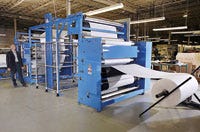Winders go wider, smarter, more flexible upload
Instead of winding foam onto master rolls and cutting the rolls down to specific lengths and widths in a separate process, a new technology incorporates these downstream functions into the extrusion process itself.
July 15, 2009
Instead of winding foam onto master rolls and cutting the rolls down to specific lengths and widths in a separate process, a new technology incorporates these downstream functions into the extrusion process itself.
Complete Winding Solutions (CWS) has developed a winder that grants extruders in-line capabilities for processing foams from 1 to 16 mm thick. In addition to core/coreless winding modes, tapeless transfer, perforation, slitting in multiple rolls, partial multiple-blade slits, lamination of narrow tape, and automatic end-tape applicators, CWS says the system has a user-friendly operator panel that provides continuous self diagnostics and true remote access.
|
CWS (Richmond Hill, ON) was launched by Peter Tkach in February 2008. Tkach, who has a Ph.D. in mechanical engineering fortified by decades of web-handling experience, points out that foam is a particularly challenging material for several reasons. Among them: foam continues to expand for several hours after extrusion; its inherent surface friction makes it unforgiving; foam layers can’t compensate for any irregularities as they’re wound by sliding on each other; and when tension is not accurately maintained, rolls can become uneven or telescope.
Understanding that proper tension would be key to foam winding, Tkach focused on an advanced motion control. Traditionally, motion-control systems require separate programming of the drives controlling the motors and the programmable logic controllers (PLC) that operate all start/stop functions, air actuators, web-tension controls, and sensor systems. Given the need for miniscule response times, CWS teamed with Siemens for the motion-control technology. The Simotion “3-in-1” was chosen since it runs all motion control and technology functions on shared control hardware. Simotion features an IEC 61131-3-compliant PLC, which allows it to control both the motion sequence as well as the entire machine.
The Profibus communication protocol allows the Simotion to be integrated with OEM components, including the CWS winder’s Festo controls, which manage the air actuators that operate the movements of the winding system. For the HMI (human machine interface), a Siemens touch screen was applied, offering real-time access to all control functions.
CWS also wanted to ensure that isolated component failures would not force the entire system to be shut down. To achieve this end, the company installed a network of sensors that monitor more than 400 variables on the machine. Sensor readings are instantly communicated through the Simotion, giving real-time self-diagnostic information to operators, allowing them to precisely locate any malfunctions.
The winder’s two-stage architecture allows bad product to temporarily be redirected from the winding module, so that operators can address line problems without costly extruder shutdowns. In addition, Simotion’s Scalance technology allows full, remote Internet accessibility to any component on the winder. Simotion and the HMI grant operator control and monitoring through an integrated Profibus Ethernet or Profibus interface. The winder’s remote maintenance, diagnostics, and teleservice functions can also utilize these interfaces. A CWS service technician with Internet can collaborate with operators to troubleshoot problems, install program updates, change formulas, and even operate the line (with proper security access). Webcams can also offer live video of the equipment.
Don Liddle of Siemens Canada Ltd. (Burlington, ON) said the winder can run film or foam products, supporting blown- or cast-film lines. Speeds range from 1000 ft/min for film and 500 ft/min for foam, with systems already installed in Europe. —[email protected]
About the Author(s)
You May Also Like



